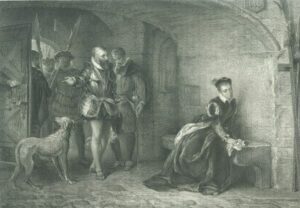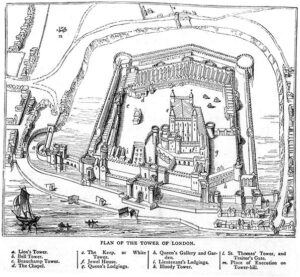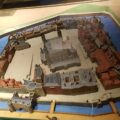
We can only imagine the sheer terror she felt when Mary I’s council turned up at her doorstep on the 16th March to formally charge her with being involved in Wyatt’s Rebellion, the revolt which had taken place in January and February 1554. Elizabeth was told that Mary wanted her sister taken to the Tower for questioning and that she would be escorted there the next day.
On the 17th March 1554 two of Mary I’s councillors, Winchester and Sussex, arrived to escort Elizabeth to her prison by water. This was when Elizabeth wrote what David Starkey calls “the letter of her life”, the famous Tide Letter, so-called because as Elizabeth wrote this letter to her sister the tide turned, making it impossible to take Elizabeth to the Tower that day. Elizabeth’s delay tactics gave her a few more hours at home but the words of her letter fell on deaf ears, Mary was determined to see her sister taken to the Tower and interrogated.
Click here to read a transcript of the Tide Letter.
Video from TheBullen1’s YouTubeChannel
There is also a wonderful clip from Elizabeth R, starring Glenda Jackson at http://www.youtube.com/watch?v=PdSWbJEr-wg
To the Tower
On Palm Sunday, Elizabeth was taken from Whitehall to the Tower of London by boat, along the Thames. According to “The Miraculous Preservation of the Lady Elizabeth, now Queen of England”, a tract which was added to John Foxe’s famous “Book of Martyrs” ( or “Acts and Monuments”), when the boat landed at Traitor’s Gate Elizabeth refused to budge and when she finally did get up and get out of the boat she said:-
“Here landeth as true a subject, being prisoner, as ever landed at these stairs.”
Wonderful words but, as David Starkey points out, Elizabeth did not enter the Tower through Traitors Gate as it was low tide, instead, she was taken to Tower Wharf. However, her entry into the Tower would have been terrifying as she would had to have walked past the Tower menagerie, past a line of guards and under the Bloody Tower where she may well have seen, across the court, the scaffold left over from the execution of Lady Jane Grey, another woman implicated in Wyatt’s Rebellion.

Although “The Miraculous Preservation” refers to Elizabeth’s prison as a “dungeon” and some books and websites state that Elizabeth was imprisoned in the Bell Tower, Starkey writes of how Elizabeth was imprisoned in the royal palace in the inner ward of the Tower of London, the palace which had been renovated by her father, Henry VIII, for her mother Anne Boleyn’s coronation but also the place where her mother had been imprisoned before her execution. Elizabeth may well have had luxurious accommodation and around a dozen servants, but she was a prisoner and must have felt that she was surely going to end her days in the Tower just like her mother, executed as a traitor.Prisoner
On Good Friday, Elizabeth was interrogated by the Queen’s council. Wyatt had refused to implicate Elizabeth in his plot so the council were hoping that Elizabeth would break and provide them with the evidence they needed to get rid of her, Elizabeth did not, she kept her wits about her.

As a result of all of this uncertainty, Elizabeth was granted more freedom and, although still a prisoner, was permitted to walk in the palace’s privy garden. The story in “The Miraculous Preservation” of a boy bringing flowers to Elizabeth and Elizabeth’s fellow prisoner trying to communicate with her through this boy (the son of an officer of the Tower) is actually true as it is confirmed in a report by Simon Renard to the Queen. I love the way this true story is used in “Virgin and the Crab” as John Dee’s way to communicate to Elizabeth through the flowers, using the meanings of the flowers which he once taught her to make messages – wonderful! Elizabeth was also permitted to walk in the great gallery and this extra “freedom” must have given Elizabeth hope that Mary was going to release her and spare her life. Did she dare hope?
Freedom, Sort Of
Elizabeth’s hopes were dashed when the new Constable of the Tower, Sir Henry Bedingfield, was ordered on the 4th May 1554 to raise a hundred troops. Elizabeth must have been truly terrified to see all of these new guards – surely this meant that she was going to be executed and that these guards were for crowd control. However, Mary had decided to release her sister from the Tower and place her under house arrest. On the 19th May, the anniversary of her mother’s execution, Elizabeth was escorted from the Tower and taken by water to Richmond.
Was Elizabeth relieved and happy? No. Starkey writes of how that night at Richmond was “one of the most disturbed nights of her life” because Elizabeth was convinced that she was going to be assassinated. “For this night, I think to die” is what she told her gentleman usher and I can understand her feeling this way – it would be convenient for Mary if Elizabeth was dispatched by an intruder, something that Mary could not be held accountable for.
After an awful night at Richmond, Elizabeth was taken to Woodstock in Oxfordshire, a journey which took 4 days and a journey which showed Elizabeth’s popularity as people lined the streets to see her and her litter became laden with gifts. It was at Woodstock that she was going to be put under house arrest and carefully watched, it was not really freedom was it? Elizabeth was quite aware of this and, in a message to her servants, she referred to a verse from St Matthew’s Gospel:-
“Behold, I send you forth as sheep in the midst of wolves; be ye therefore wise as serpents, and harmless as doves.”
Elizabeth knew that both she and her servants would have to keep their wits about them if they were to survive, her enemies would be watching.
Conclusion
It is easy for us, over 450 years on, to look at this episode as just a “blip” in the life of this iconic queen but Elizabeth was in real danger. Elizabeth had many enemies at this time and Mary was being pushed by her council and by her husband to deal with Elizabeth and to even get rid of her. Mary had been forced to get rid of Lady Jane Grey, her relation and a girl with Tudor blood, and Elizabeth’s links with rebel leaders during Wyatt’s Rebellion could have cost Elizabeth her life. Elizabeth must have felt that the axe was quite literally hanging over her those two months in the Tower and it was, her life was on the line. Fortunately for Elizabeth, she kept her cool under enormous pressure, as did her servants, and Wyatt refused to implicate her. There was just no firm evidence against Elizabeth and Mary knew how popular Elizabeth was, to execute a daughter of Henry VIII would be stirring up trouble.
Sources
- “Elizabeth” by David Starkey
- “Virgin and the Crab” by Robert Parry








Lovely story – and we never get tired of hearing it. Thank you Claire for providing a balanced appraisal (as always).
David Starkey is such a party pooper, isn’t he. The fiction is so often more thrilling than the facts.
David Starkey the party pooper! I like that! I do like the fact that the boy with the flowers story is true though as I love that bit in Robert’s book, a wonderful way to send secret messages.
She was so brave, so young…I do not know how she controlled herself to the extent she had to . Maybe her later temper tantrums were a direct result of the strain Mary put her under for 6 years. Her teenage headaches may well have been migraines caused by stress. Lastly, David Starkey – it’s pretty clear to me he doesn’t really like women – his “6ix Wives” kept banging on about Anne Boleyn being sexy ( on TV as well as in his books). I know he’s gay (big deal) but I suspect he’s also a misogynist. One of our history teachers was the same and made it plain to pretty young women that he was going to under-mark them and ignore them in seminars and told my dearest uni friend that he had just viva-ed her to see if she would get a 2-1 but he’d taken great pleasure (his words) in keeping her at a 2:2 status – M.C.P!
What strong girl to be arested by her sister the Tower as most didnot leave once they arived.A very brave girl and Queen as her mother Queen Anne, I watch the you tube that was Glenda Jackson?A great actress,she was also excellent in Mary Queen of Scots as, Queen Eliabeth1 as well as Venessa Redgrave as Mary Queen Scots.I still shutter from that clip on YT just think if it were you going on that dreaded boat ride? THX Barones Von Reis
I Love Glenda Jackson, she portrayed Elizabeth so flawlessly! to me, she’s the definitive Elizabeth.